It's the last week to see works of iconic artist Keith Haring at the Akron Art Museum
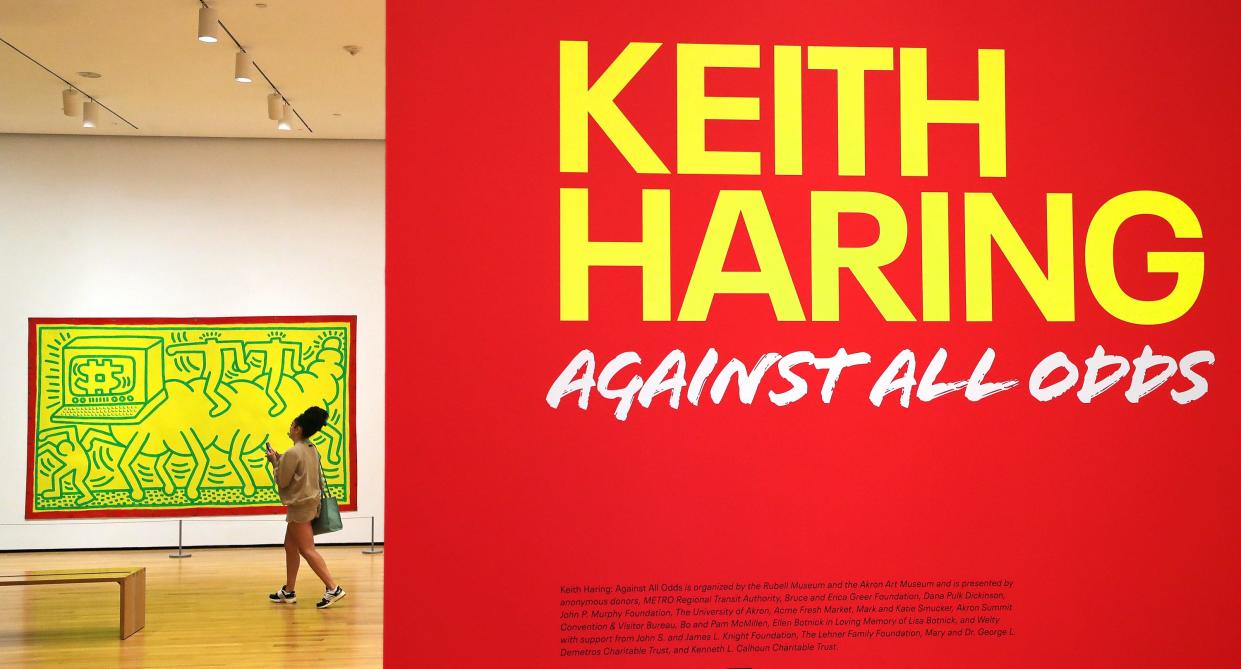
- Oops!Something went wrong.Please try again later.
When artist Keith Haring created chalk drawings in New York subway stations early in his career in the 1980s, he never signed them. Even so, New Yorkers quickly recognized his distinctive style.
Haring saw artmaking as a communal activity, a performance that he wanted crowds to watch. Today, millions of people around the world instantly recognize Haring's iconic figures, including outlines of dancing figures, barking dogs and crawling babies.
Now, Northeast Ohio fans of the artist, who died at age 31 in 1990, can get an intimate look into Haring's style, ideas, personality and legacy at the Akron Art Museum with "Keith Haring: Against All Odds." The show opened last month and continues through late September.
At first glance, some of Haring's pieces — including an untitled 1984 work featuring a huge yellow caterpillar with a computer head and two headless people riding it — look like pure whimsy. But look more closely, and you'll see the dollar sign on the computer screen, indicating an analogy between a hungry caterpillar as an eating machine and an early personal computer devouring its surroundings.
These details indicate Haring is commenting on growing technology leading to greed and exploitation.
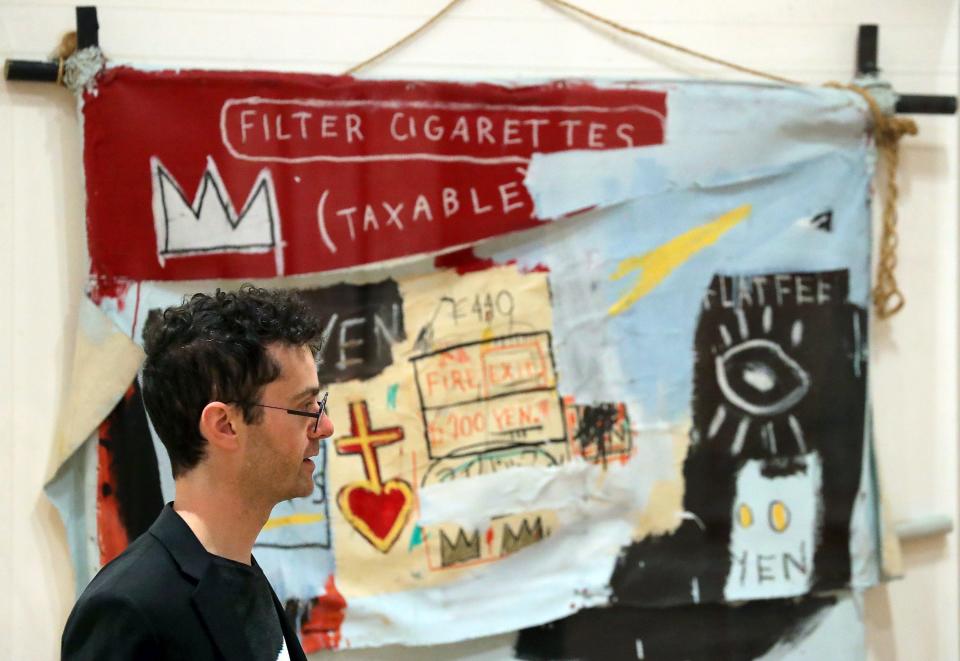
"These headless people, maybe they're kind of losing their heads riding the new technology," museum curator Jeff Katzin said. "There's always a balance between a political message and something that is eye catching and fun, even when the subject matter is intense."
Haring's style is so iconic, young people born well after he died are plugged in to his pop culture imagery, which continues to proliferate with T-shirts, shoes, bags and more sold everywhere from PacSun and H&M to Adidas and Converse.
"We really have seen a greater number of (social media) posts of people of all ages interacting in the exhibition space, and everybody's putting their own fun, creative spin on how the works are making them feel," said Alexandra Vukoder, museum spokeswoman. "It's a real testament to how inspirational Keith Haring's work was and how it's relatable to all ages."
That's the way that Haring, whose goal was to break down barriers between high and low art, wanted it. When his paintings and drawings began to demand high prices, he opened his Pop Shop in 1986 in SoHo to keep his art accessible to broad audiences through T-shirts, posters, buttons and more.
Haring used to draw on people's clothes and give his art away at his exhibitions, to the chagrin of his gallery reps. Items from his Pop Shop were so popular, Katzin recently saw a woman at the Akron Art Museum who had cut out a Haring design from her original, worn-out Pop Shop T-shirt from the '80s and proudly sewed it onto a fresh T-shirt.
For subscribers: 'A place for Akron to have some fun': DeJuan's restaurant to open downtown in former Bricco space
For the Akron show, Newton Falls artist Ron Copeland has re-created Haring's Pop Shop, which remained open until 2005, well after Haring's death from AIDS in 1990. The immersive environment, covered with black and white Haring-style murals on the walls, floor and ceiling, includes his T-shirts tacked to the walls, a bean bag chair with pillows decorated with his designs and a table with a checker set and other games featuring Haring's art.
Two works in the Akron show — a huge, iconic painting of two figures dancing around a radiant heart on a vinyl tarp and a "Statue of Liberty" sculpture that Haring created with graffiti artist Angel Ortiz — moved on to a traveling exhibition Sunday.
On Wednesday, two additional works replaced them, including Haring's iconic caterpillar piece on a canvas tarp and a small 1987 silkscreen of two figures, one with an arm around the other, standing beneath a red heart.
Who is Keith Haring?
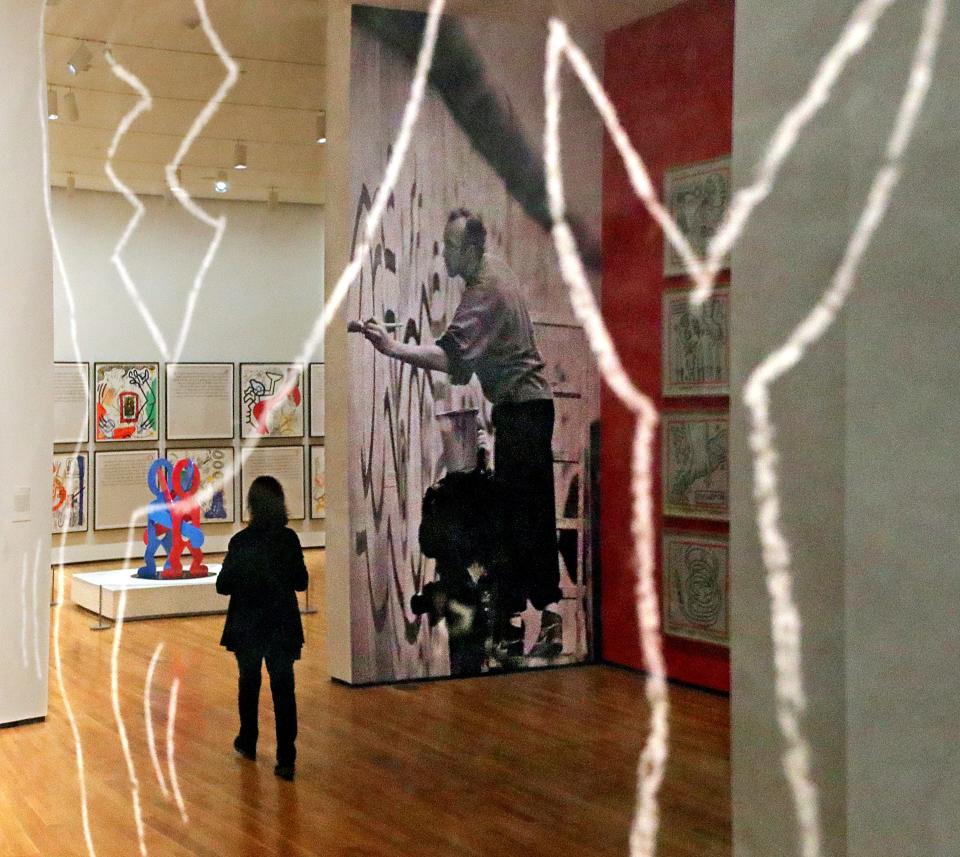
Haring grew up in the small town of Kutztown, Pennsylvania, where his dad made comic books as a hobby and young Haring copied images from comic books and watched Disney movies. He studied graphic design for a year at Ivy School of Professional Art in Pittsburgh before moving to New York to study painting and more at the School of Visual Arts in 1978, where he dropped out after a year.
His goal was to reach as many people as possible with his art. The prolific Haring worked quickly, creating more than 5,000 chalk drawings in the New York subways from 1980 to 1985.
"Most of all, it was a connection with the public who were going about their daily lives," Katzin said.
Drawing on black paper that covered up old advertisements, Haring worked quickly to avoid police, who issued him more than 100 tickets and arrested him once for criminal mischief for drawing in the subway.
His studio was on the ground floor of a Manhattan building where he kept his door open to encourage people to come in and ask what he was working on.
More: Akron's Serrin Joy sings at alma mater Miller South, dishes on 'American Idol' experience
Haring's career took off in 1982, when his work was displayed on the Spectacolor billboard in Times Square, he had his first gallery exhibition and first major mural in New York. His work was also exhibited that year in Kassel, West Germany, alongside contemporary artists including Andy Warhol and young graffiti artist Jean-Michel Basquiat.
Haring's pieces exploded into paintings, drawings, large-scale murals, fashion and pop culture. That ranged from a commission from the Checkpoint Charlie Museum to paint a mural on the Berlin Wall to creating a print for fashion designer Vivienne Westwood for a fabric she used in a skirt that Madonna wore in her "Borderline" video.
Haring became close friends with Madonna and fellow artists Basquiat and Warhol, who influenced his work. Part of Akron's "Keith Haring: Against All Odds" exhibit features the art of friends/contemporaries including Basquiat and Warhol.
In nods to pop culture, Haring's 1981 drawings of Elvis Presley and Marilyn Monroe, Warhol-style, are drawn on top of commercially printed posters and a collection of enamel paintings depict Mickey Mouse being zapped by an alien UFO.
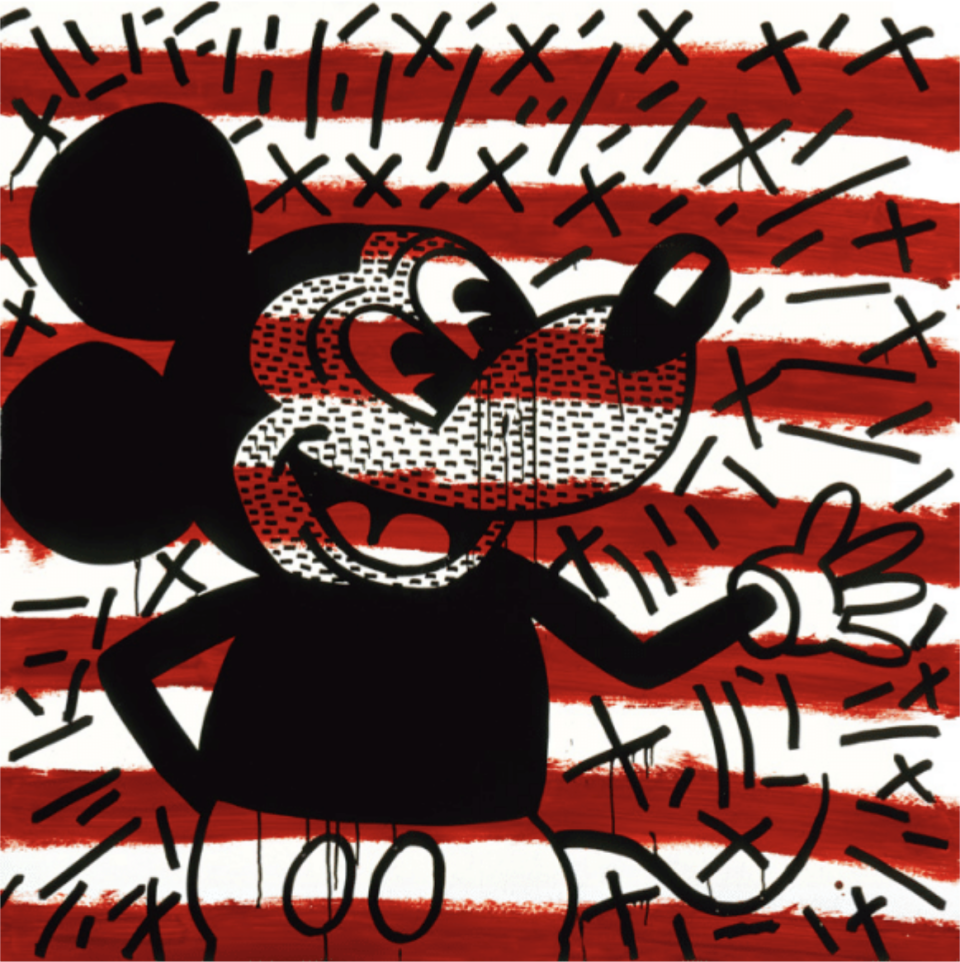
Keith Haring's identity as gay man important as an artist
Haring was a proud, openly gay man who was diagnosed with HIV in 1987 and AIDS in 1988. During the last couple years of his life, he used his art for AIDS activism and awareness.
"Haring's identity as a gay artist was very important to him," Katzin said. "That factors into a lot of his art in many different ways, sometimes through activism, sometimes through content that's very personal," Katzin.
Some of Haring's works in Akron contain sexual imagery. A sign at the front desk of the museum lobby carries the disclaimer that some works in the exhibit may not be appropriate for all audiences. Parents may ask staff to show them reproductions of those images.
Although his sexuality was an important part of his work, Haring did not include sexual images in his subway drawings or in public murals that children would see.
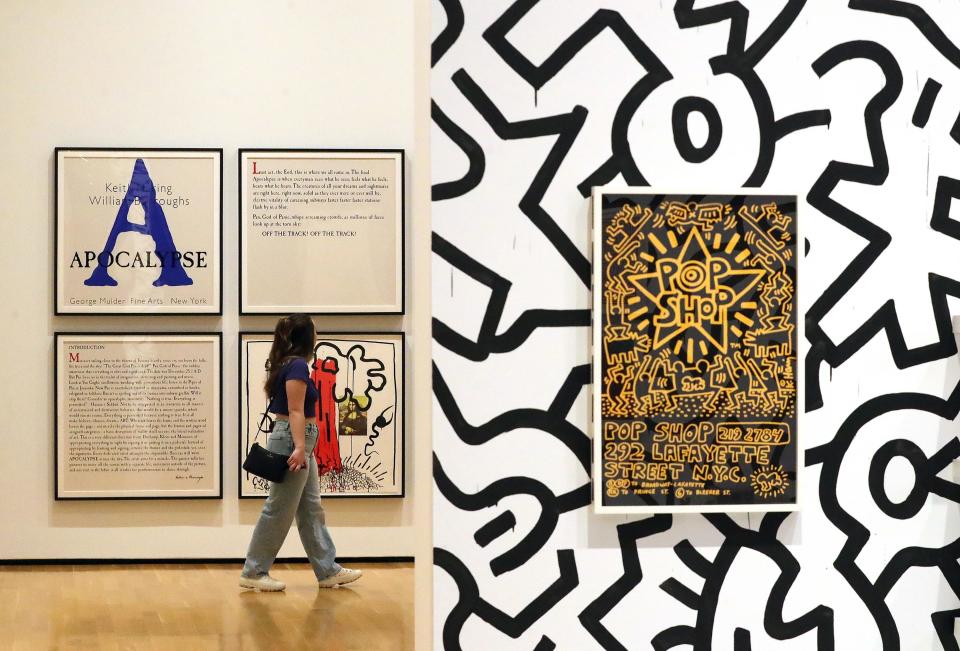
"Keith Haring: Against All Odds" also features the poster "Ignorance = Feat/Silence = Death" that Haring designed in 1989 for the activist group AIDS Coalition to Unleash Power (ACT UP). The design of three figures, posed to suggest the Japanese proverb "see no evil, hear no evil, speak no evil," warns of the dangers of U.S. institutions turning a blind eye to the AIDS crisis.
After 1987, Haring knew his life was limited. He founded the Keith Haring Foundation in 1989 to support charitable causes for children as well as education, research and care surrounding HIV and AIDS.
The art that Haring created in his brief yet dense career continues to be part of his legacy artistically and philanthropically, Katzin said: "It's this really short, 10-year window in which he made an amazing impact."
Arts and restaurant writer Kerry Clawson may be reached at 330-996-3527 or kclawson@thebeaconjournal.com.
Details
Exhibit: "Keith Haring: Against All Odds"
Organizers: The Akron Art Museum and Rubell Museum of Miami
Where: Akron Art Museum, 1 S. High St., Akron
When: Continuing through Sept. 24
Gallery hours: 11 a.m. to 5 p.m. Wednesday-Sunday, 11 a.m. to 8 p.m. Thursday
Cost: $12 general admission, $10 senior citizens, $8 student with ID, free for University of Akron students, faculty and staff. Gallery admission free every Thursday.
Information: 330-376-9186, akronartmuseum.org
This article originally appeared on Akron Beacon Journal: Keith Haring art exhibit leaving Akron Art Museum Sept. 24

